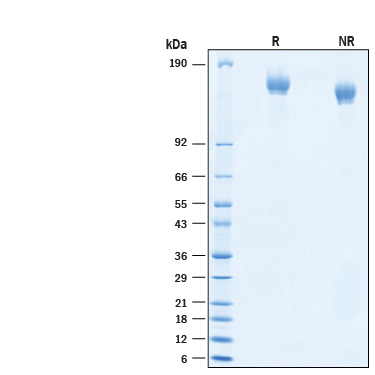Recombinant SARS-CoV-2 B.1.620 Spike GCN4-IZ His Protein, CF Summary
Product Specifications
| Recombinant SARS-CoV-2 B.1.620 Spike (Val16-Lys1211) (Pro26Ser, His69del, Val70del, Val126Ala, Tyr144del, Lys242del, Ala243del, Lys244del, His245Tyr, Ser477Asn, Glu484Lys, Asp614Gly, Pro681His, Thr1027Ile, Asp1118His) (Arg682Ser, Arg685Ser, Lys986Pro, Val987Pro) Accession # YP_009724390.1 | GCN4-IZ | 6-His tag |
| N-terminus | C-terminus | |
Analysis
Product Datasheets
Carrier Free
CF stands for Carrier Free (CF). We typically add Bovine Serum Albumin (BSA) as a carrier protein to our recombinant proteins. Adding a carrier protein enhances protein stability, increases shelf-life, and allows the recombinant protein to be stored at a more dilute concentration. The carrier free version does not contain BSA.
In general, we advise purchasing the recombinant protein with BSA for use in cell or tissue culture, or as an ELISA standard. In contrast, the carrier free protein is recommended for applications, in which the presence of BSA could interfere.
10917-CV
| Formulation | Lyophilized from a 0.2 μm filtered solution in PBS with Trehalose. |
| Reconstitution | Reconstitute at 500 μg/mL in PBS. |
| Shipping | The product is shipped at ambient temperature. Upon receipt, store it immediately at the temperature recommended below. |
| Stability & Storage: | Use a manual defrost freezer and avoid repeated freeze-thaw cycles.
|
Scientific Data
 View Larger
View Larger
2 μg/lane of Recombinant SARS-CoV-2 B.1.620 Spike (GCN4-IZ) His-tag Protein (Catalog # 10917-CV) was resolved with SDS-PAGE under reducing (R) and non-reducing (NR) conditions and visualized by Coomassie® Blue staining, showing bands at 150-170 kDa.
Reconstitution Calculator
Background: Spike
SARS-CoV-2, which causes the global pandemic coronavirus disease 2019 (Covid-19), belongs to a family of viruses known as coronaviruses that also include MERS-CoV and SARS-CoV-1. Coronaviruses are commonly comprised of four structural proteins: Spike protein (S), Envelope protein (E), Membrane protein (M) and Nucleocapsid protein (N) (1). The SARS-CoV-2 S protein is a glycoprotein that mediates membrane fusion and viral entry. The S protein is homotrimeric, with each ~180-kDa monomer consisting of two subunits, S1 and S2 (2). In SARS-CoV-2, as with most coronaviruses, proteolytic cleavage of the S protein into S1 and S2 subunits is required for activation. The S1 subunit is focused on attachment of the protein to the host receptor while the S2 subunit is involved with cell fusion (3-5). The S protein of SARS-CoV-2 shares 75% and 29% aa sequence identity with S protein of SARS-CoV-1 and MERS, respectively. The S Protein of the SARS-CoV-2 virus, like the SARS-CoV-1 counterpart, binds a metallopeptidase, Angiotensin-Converting Enzyme 2 (ACE-2), but with much higher affinity and faster binding kinetics through the receptor binding domain (RBD) located in the C-terminal region of S1 subunit (6). It has been demonstrated that the S Protein can invade host cells through the CD147/EMMPRIN receptor and mediate membrane fusion (7, 8). Polyclonal antibodies to the RBD of the SARS-CoV-2 protein have been shown to inhibit interaction with the ACE-2 receptor, confirming RBD as an attractive target for vaccinations or antiviral therapy (9). There is also promising work showing that the RBD may be used to detect presence of neutralizing antibodies present in a patient's bloodstream, consistent with developed immunity after exposure to the SARS-CoV-2 (10). Several emerging SARS-CoV-2 genomes have been identified with mutations compared to the Wuhan-Hu-1 SARS-CoV-2 reference sequence. The B.1.620 variant was identified in Lithuania but most likely orginiated in central Africa and it contains several mutations of interest that effect viral fitness and transmissibility including S477N, E484K, D614G, and P681H (11). Both S477N and E484K mutations are found in the same loop of the RBD domain at the edge of the ACE-2 binding interface (12). The S477N mutation has been identified enhancing the affinity for hACE-2 and resistance to multiple neutralizing mAbs (13, 14). Structural analysis points to E484K as a potentially crucial mutation as it creates a new site for hACE-2 binding and may enhance binding affinity (13). The D614G mutation is located nearby to the RBD domain and has been shown to increase viral infectivity (15). The P618H mutation is found adjacent to the furin cleavage site and is proposed to enhance S protein cleavage and increase viral infectivity (16). Additionally, the E484K substitution alone has been shown to confer resistance to several monoclonal antibodies and is responsible for the first confirmed SARS-CoV-2 reinfection (17).
- Wu, F. et al. (2020) Nature 579:265.
- Tortorici, M.A. and D. Veesler (2019) Adv. Virus Res. 105:93.
- Bosch, B.J. et al. (2003) J. Virol. 77:8801.
- Belouzard, S. et al. (2009) Proc. Natl. Acad. Sci. 106:5871.
- Millet, J.K. and G.R. Whittaker (2015) Virus Res. 202:120.
- Ortega, J.T. et al. (2020) EXCLI J. 19:410.
- Wang, K. et al. (2020) bioRxiv https://www.biorxiv.org/content/10.1101/2020.03.14.988345v1.
- Isabel, et al. (2020) Sci Rep 10, 14031. https://doi.org/10.1038/s41598-020-70827-z.
- Tai, W. et al. (2020) Cell. Mol. Immunol. https://doi.org/10.1016/j.it.2020.03.007.1.
- Okba, N.M.A. et al. (2020) Emerg. Infect. Dis. https://doi.org/10.3201/eid2607.200841.
- Dudas, G. et al. (2021) medRxiv https://doi.org/10.1101/2021.05.04.21256637.
- Lan, J. et al. (2020) Nature, 581:215
- Liu, Z. et al. (2021) Cell Host Microbe. 29:477.
- Singh, A. et al. (2020) DOI: 10.21203/rs.3.rs-106969/v2.
- Zhang, L. et al. (2020) Nat Commun. 11:6013.
- Nonaka, C.K.V. et al. (2021) Emerg Infect Dis. https://doi.org/10.3201/eid2705.210191.
FAQs
No product specific FAQs exist for this product, however you may
View all Proteins and Enzyme FAQsReviews for Recombinant SARS-CoV-2 B.1.620 Spike GCN4-IZ His Protein, CF
There are currently no reviews for this product. Be the first to review Recombinant SARS-CoV-2 B.1.620 Spike GCN4-IZ His Protein, CF and earn rewards!
Have you used Recombinant SARS-CoV-2 B.1.620 Spike GCN4-IZ His Protein, CF?
Submit a review and receive an Amazon gift card.
$25/€18/£15/$25CAN/¥75 Yuan/¥2500 Yen for a review with an image
$10/€7/£6/$10 CAD/¥70 Yuan/¥1110 Yen for a review without an image
